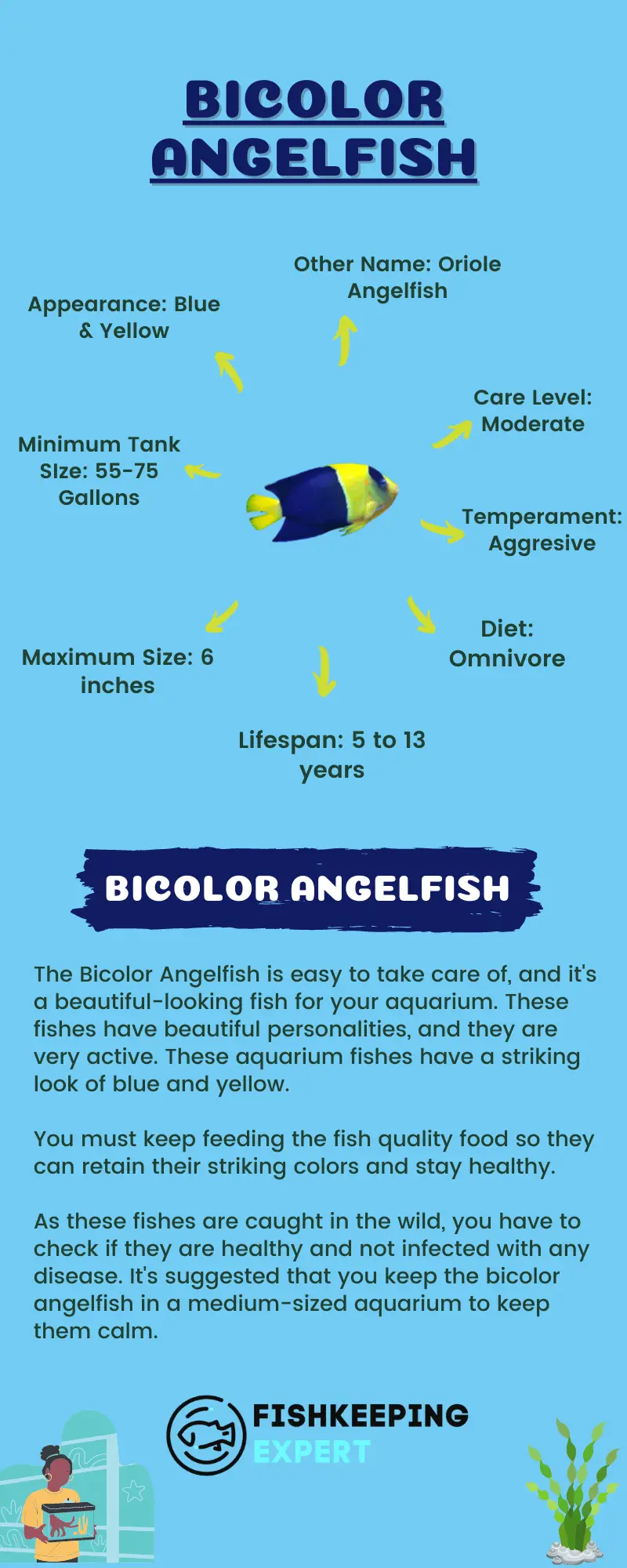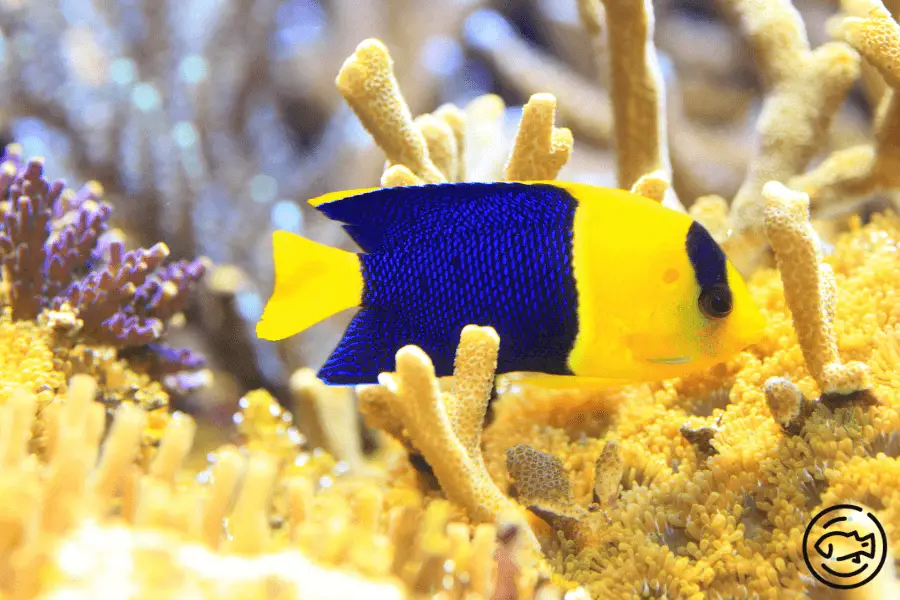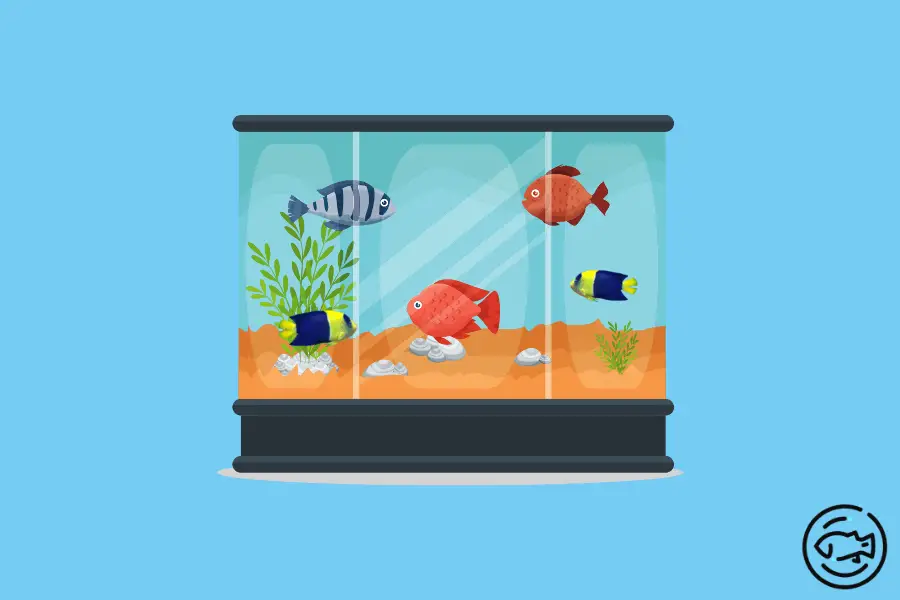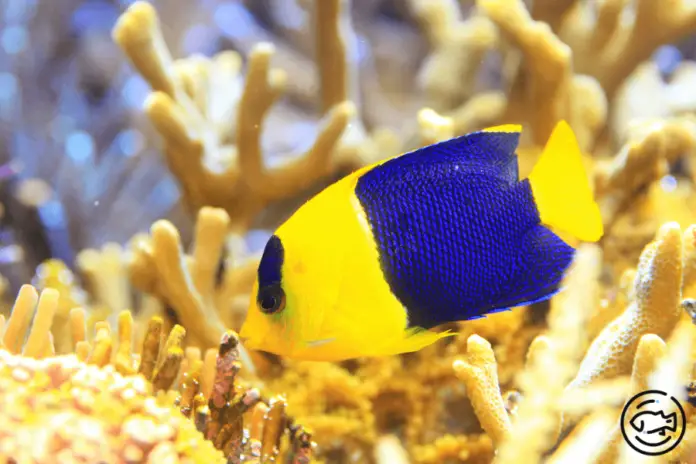You can effortlessly take care of the fish, but you must be careful while selecting their mates because the water animals are not known for their excellent behavior.
So, are you thinking of how to have such beautiful fish as pets? Let’s read more about the bicolor angelfish in this article.
Overview

The Bicolor Angelfish has the reputation of being a troublemaker, and they might become a bit tough to maintain rather than other dwarf angelfish.
The maintenance of the fish will depend on where they are coming from, as some collectors might have questionable practices regarding these fish.
You can try keeping the fish in a saltwater aquarium, but you must consider some essential things like the water source if you do not live near the sea and many more.
So, to not complicate things further, you can keep the fish in an aquarium that is not more than six months old.
You might need a 75-gallon tank with plenty of hiding spaces for the fish, therefore, you must add some rocks and ensure it has holes in them.
Bicolor angelfish do not always prefer reefs, as they will nip at the reef surface and clam areas. This is a marine species animal, and you can identify these fishes by their yellow tail and the same color on its body.
The fishes have blue rear and patterns across their eyes and above.
Bicolor angelfish is mainly known as a two-colored angel, blue and gold angel, oriole dwarf angel, oriole angelfish, and Pacific rock magnificence.
The fishes can live from 5 to 13 years, based on the location. They grow to almost six inches, which makes them smaller in size.
Natural Habitat of the Bicolor Angelfish
These fishes are native dwellers of the Indo-Pacific waters. The geographical area starts from East Africa to Japan, and the Bicolor angelfish are seen primarily near Micronesia, Samoan, and the Phoenix Islands.
These waters are mostly filled with saltwater reefs and lagoons. The fishes can swim quickly and hide under the rocks to protect themselves.
They are mostly found at 3 to 80 feet depths of water, adult fishes are found in at least 33-feet, and young ones are found in 3-feet of water.
The fish group in the wild areas varies among these sea animals. They usually like to swim alone or with their mates. The fishes are also found in a group with many females and one male to mate.
Appearance

The bicolor angelfish has beautiful colors, blue and yellow, all over. The posterior is blue, and the anterior is yellow.
The tail is also tipped yellow, with blue across its eyes. The fish will look like a lightning bolt in the saltwater aquarium because of its striking colors. Some fishes can have a gold color instead of yellow, and darker blue can be found too.
Size
These two colored fishes or oriole angelfish can grow up to six inches, which gives them a dwarfish look, therefore, they are also called dwarf angelfish.
However, most only grow up to 3-4 inches, and to keep them, the size should be proper, and you can keep younger fishes that grow only to three inches in a 55-gallon tank.
Behavior
These fishes are mostly very aggressive, and they wouldn’t like someone they dislike from their group or other species in the tank.
Most of the time, the males spend their time protecting their area from predators, and they will not tolerate other species invading their lands or a fish from their group.
The fishes’ territory consists primarily of females and one male as females tend to be aggressive towards the lower class members of the group, even in the same family. They like to keep their status in every group.
Reproduction of Bicolor Angelfish

Male fish venture to the group of females at night to mate, as one male will mate with one or more females each night. A female will release her eggs, and the male will give sperm to fertilize it.
Females can give birth to fish babies on the same day, and the higher status females give birth to more babies than the lower ranks.
They mostly stay in groups where the group of females shares one male fish. Most groups have seven females, separated by rank, and they decide which male they will mate with. The males are the dominant ones in one group.
also read: GFP Axolotl – Learn More About GFP Axolotl!
Aquarium For The Bicolor Angelfish

As these are aggressive fish, they will need a massive aquarium, and you must have to choose a tank not more than 75-gallons. The fish will not survive in captivity for long, so you must select a non-reef tank.
You can add plants, rocks with hiding caves, and poisonous coral for the fish tank. You have to provide a lot of hiding places for the fish so they can hide anytime they want in the rock holes.
The best temperature of the water should be from 72° to 78° Fahrenheit, and the Ph level should be from 8.1 to 8.4.
The fish will survive if you let them be alone in the tank, and if you keep other species, the fishes will fight and kill each other. They must carefully choose their mates, so they don’t start a brawl inside the aquarium. Also, feed them spirulina flakes, worms, shrimps, and algae.
The sensible thing you can do with this species is to keep them well fed, which means you have to take care of their diet. Try to provide them with food that will not make the fish fat. Spirulina algae are good food for this species.
Also, it’s suggested that you provide plenty of hiding places in the aquarium. The fishes like to hide and swim in and out of the holes. This way, they feel safe inside the tank.
They would like to eat the food on the rocks, which gives them freedom, although they are in captivity.
Food & Diet

Bicolor angelfish are omnivores, which means they eat both plants and seafood. You can give them Mysis, frozen shrimp, and marine algae.
The fish will not consume marine flake and pellet food, and they will also eat algae when it’s on the live rock.
Their food must contain lots of protein compared to other angelfish. The food behavior of an adult fish is different from that of young ones.
The younger fish will eat different foods you give them, like vegetable scrapes, small crustaceans, shrimps, and worms.
On the other hand, the adults will stick to spirulina algae. Also, some of them might prefer large polyp corals, tunicates, sponges, corals, and worms. You can feed them store-bought food with fresh or frozen shrimp.
Feeding bicolor angelfish is easy, as they like flakes and frozen items. However, some experts have reported a different story.
If your fish is facing a problem eating the food you provide, you can go for frozen foods first and slowly introduce them to other foods. Make sure to give them foods that are spirulina enriched.
You might find some cubes that are filled with spirulina. It would benefit if you also cleaned the aquarium to keep the fish happy and healthy. If the food remnant float in the water, you must change it.
Common Diseases
These fish are similar to dwarf angelfish. They can be very aggressive towards their group or other species. So, you have to be very careful about the aquarium. Ensure the water is transparent and not cloudy, which can create diseases and kill the fish. Check out the conditions these fish can get.
- Bacterial Diseases– These fish are vulnerable to bacteria. Parasitic and protozoan diseases can infect them. The standard type of bacteria is vibrio bacteria which can cause internal damage, and this infection can be complicated, as it can create dropsy, Popeye, and red streaks. This disease spreads faster than others and can kill all the fish within some days. Firstly, it appears in the pectoral area and extends to the whole body.
You can treat this infection with freshwater dips for fifteen minutes. This will kill the bacteria. You can also give medication that contains cleated copper. But it will work if the fishes are sensitive to this material.
- Parasitic Infections- These two colored angelfish tend to get affected by protozoan and parasitic diseases. In addition, they can have white spots, crypt, and marine ich. The symptoms of the parasitic infection are several white dots on the body and fins, scratching, and flashing.
The dots will go away, but they can appear again after some days. The fish will have breathing troubles as the infection blocks the gills. You have to consult a vet to treat the disease.
- Viral Infections– Viral infection can be very damaging for these fish. If one fish is exposed, it will develop the signs within four days of getting infected. It can cause death in both young and adult fish. Bicolor angelfish are not bred while in captivity, as they are caught in the wild and might suffer from various diseases. You can minimize the conditions by keeping them in a clean tank. You must change the water and clean the aquarium. Keep the water at the right temperature and ensure the pH level is correct. Keep a close watch on the aquarium to ensure the fishes are happy and healthy.
Pros and Cons of Bicolor Angelfish
There are a few pros and cons of keeping Bicolor Angelfish as a pet. Let’s read about them in brief.
Pros
These fish have a striking color, which can elevate the appearance of any room. You need natural lighting to keep them in the tank. As the child of the wild, these fishes are great swimmers, and they will roam in the tank all day long. The fishes are also good because they can live up to twelve years.
Cons
The first problem with the fish is they will not do well in a reef aquarium. In addition, they are not much friendly but rather aggressive even to their group. You will not be able to keep the fish with other species; you keep the single in one aquarium, which makes maintenance easy.
Are Bicolor Angelfish Friendly?
The bicolor angelfish is a bit of aggressive than friendly, and this is mainly because they are caught in the wild and have a brutal temper.
They can be very territorial when you put them into the aquarium. You must choose their mates carefully as it would benefit if you remained away from putting other species with these fish.
You can keep poisonous coral in the tank so they do not destroy the water and make sure to put lots of rocks with holes. The fish likes to hide there.
Are Reefs Safe For Bicolor Angelfish?
These fishes are not reef safe as it can bite on the polyps and corals, damaging the aquarium’s inside. It would be beneficial to keep them in a non-reed water enclosure and add many caves and rocks.
You can add poisonous corals, which the fish will not eat and will not damage it.
You can also keep them with soft corals like Cladiella, Sarcophytom, and Sinularia. Some experts even succeeded in keeping bicolor angelfish with mushroom anemones in the tank.
The fish can also eat feather dusters and starfish. They love to eat large shrimps, crabs, and snails, but you have to offer them the food right before them.
Conclusion
The care type is moderate for the fish, and it would help if you kept them with lots of rocks inside the aquarium, so they get good places to hide. Make sure the aquarium is clean; if it gets dirty, you have to clean it and change the water.
You must keep feeding the fish quality food so they can retain their striking colors and stay healthy. As these fishes are caught in the wild, you have to check if they are healthy and not infected with any disease. It’s suggested that you keep the bicolor angelfish in a medium-sized aquarium to keep them calm.


